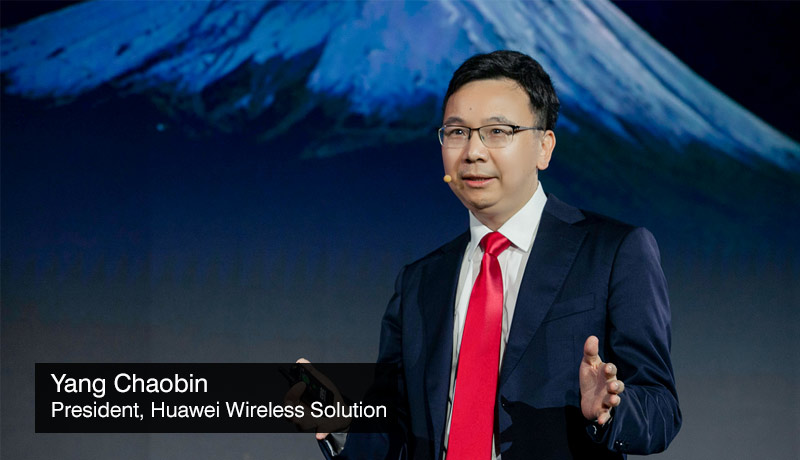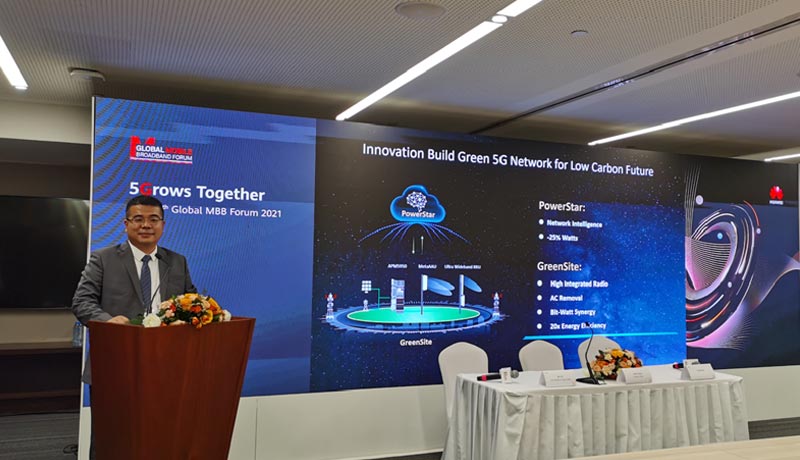
During the 12th Global Mobile Broadband Forum (MBBF) 2021, Huawei announced methods for building ubiquitous gigabit networks and a “5Gigaverse society,” as changes in user behaviour and industry digitization place greater demands on 5G networks.
Yang Chaobin, President of Huawei Wireless Solution, delivered a keynote speech at the forum, noting: “5G is developing rapidly worldwide, with more than 170 networks built and nearly 500 million users developed within two years. As 5G commercial deployment enters a new phase, users need more continuous experience, and industry digitalization poses new requirements on 5G capabilities. Therefore, we believe that the next step is to evolve 5G from hotspot to all-scenario continuous coverage, from Gbps to 5Gigaverse, and from pilot industry to all-industry digitalization, to build a ubiquitous gigabit network and a 5Gigaverse society.”
By 2030, mobile networks are predicted to carry more traffic than wired networks, making them the primary carrier of internet traffic. In the meantime, progress has been achieved in the digitalization of industry. In more than 20 sectors around the world, 5G has allowed more than 10,000 scenarios. 5G capabilities will continue to grow in the future to accommodate fragmented connections across numerous industries, resulting in an IoT space with hundreds of billions of connections.
“Innovation will never stop,” adds Chaobin. “The next decade will be a decade of 5G. 5G will continue to evolve and innovate toward 5.5G. We hope to work with global partners to continuously innovate based on user experience and industry requirements to take user experience to new heights while digitally transforming industries.”
Massive MIMO and ultra-wideband technologies have proven to improve user experience by ten times in two years of commercial 5G deployment, and they have become the preferred technology of most operators across the world.
Massive MIMO is now widely accepted as the best option for deployment with continuous large-bandwidth TDD channels. Huawei launched Massive MIMO AAU with 400 MHz bandwidth for markets having discrete spectrum to simplify deployment. Huawei also introduces BladeAAU, a streamlined single-antenna deployment solution that combines sub-3 GHz and Massive MIMO for markets with limited antenna space. Huawei also unveiled the new 64TRX MetaAAU, which has enhanced performance and energy saving.
Huawei’s brand-new MetaAAU introduces ELAA technology and the unique AHR Turbo solution, marking a new breakthrough in Massive MIMO coverage and energy efficiency.
Where new TDD bands have not yet been licenced, existing FDD spectrum can be used to upgrade established bases using Massive MIMO and ultra-wideband technologies, lowering deployment costs and boosting 4G and 5G experience and capacity.
The Huawei 4T4R RRU is a high-power, ultra-wideband router that supports three bands in a single box, making multi-band network deployment easier. It supports full-band and all-RAT dynamic power sharing, resulting in a 30% improvement in user experience and a 30% reduction in power usage.
Pole sites also enhance macro coverage with on-demand, simpler deployment for coverage hole fill-up and at hotspots, according to Huawei. This is significant for mobile networks in congested places like streets and neighbourhoods, where site acquisition is difficult, because it allows them to quickly build macro sites by leveraging light poles and walls. Huawei developed a series of simple solutions in 2020 to assist operators in quickly filling 5G coverage gaps. Huawei released EasyBlink 2.0, a new pole site solution, this year to make pole site deployment even easier.

Huawei also offers the only distributed Massive MIMO technology in the industry for a 5G indoor ubiquitous Gbps experience. Operators must undertake multi-RAT and multi-band deployment in indoor spaces in order to provide the best possible user experience. Huawei’s LampSite solution offers several radio access technologies in TDD and FDD bands in one box, as well as indoor distributed Massive MIMO. These capabilities allow it to quadruple network bandwidth over 4T4R, delivering a ubiquitous Gbps experience indoors. It’s perfect for providing service in large interior spaces like airports, train stations, and shopping malls.
Custom coverage is frequently required at factories and campuses on the macro networks that are utilised to maintain continuous coverage. Operators can choose between LampSite and EasyMacro to swiftly deploy 5G coverage in both indoor and outdoor campus areas. Operators can also provide Gigabit uplink data speeds with the SUL solution. Huawei’s 5GtoB solutions make it easy for operators to address the diverse needs of various industries in uplink ultra-wideband, high-precision positioning, low latency, and high reliability.
Multi-band and multi-standard coexistence will be a prominent trend in this decade. Operators must coordinate macro, pole, and indoor 3D network operations and maintenance to suit the diverse needs of toB, toC, and toH users, as well as maximise network performance while reducing power consumption. This emphasises the importance of creating intelligent wireless networks.
With this in mind, Aaron Jiang, President of Huawei’s SRAN Product Line, announced the GreenSite and PowerStar2.0 technologies, which will assist operators in building green, low-carbon 5G networks. The GreenSite solution combines cutting-edge software and hardware with novel architecture, site construction, and algorithms to increase energy efficiency by 20 times. Under typical setups, the PowerStar2.0 solution introduces additional intelligent energy-saving features to base stations and networks, reducing energy usage by approximately 25% through multi-dimensional coordination.